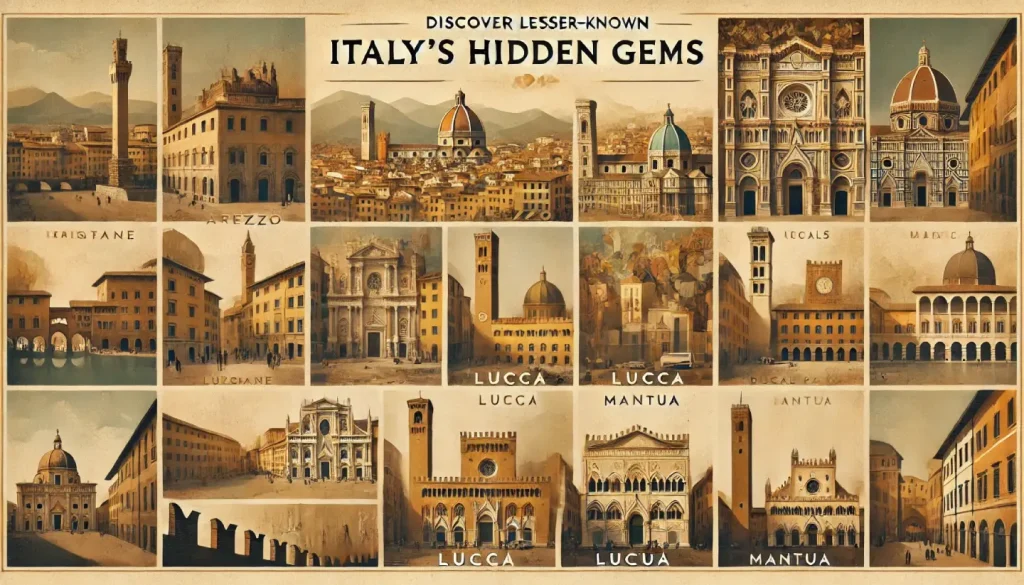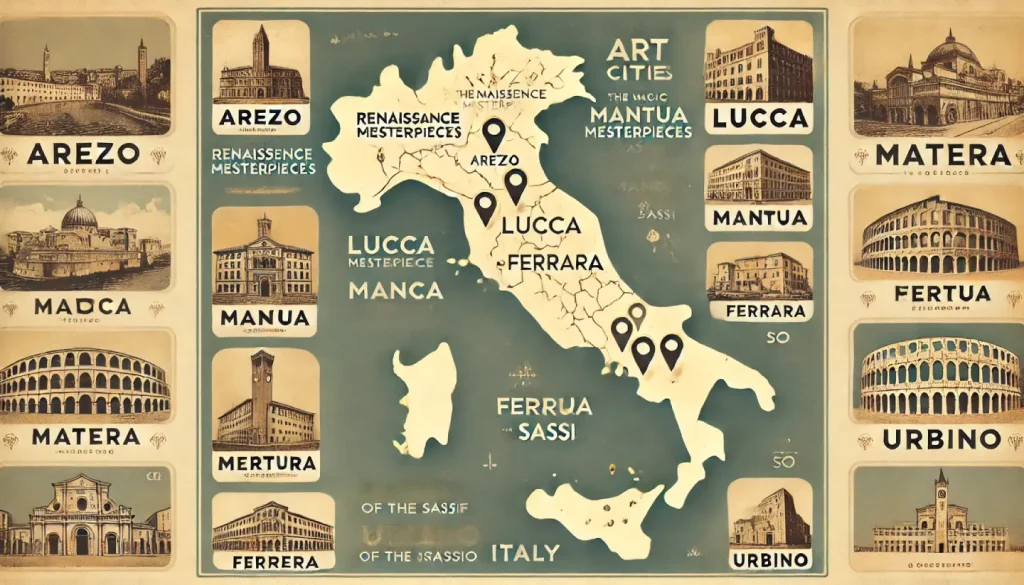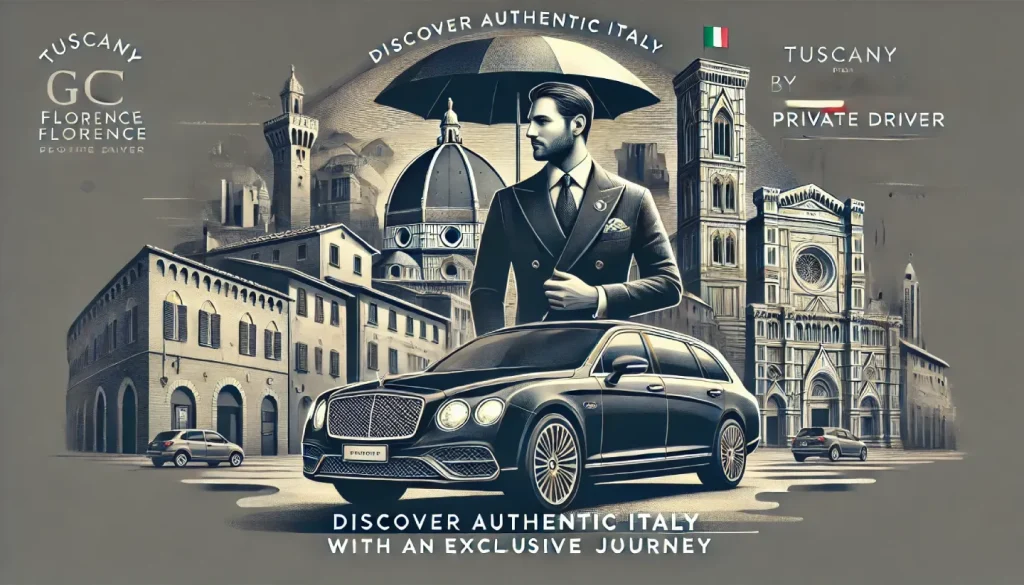
Italy is an open-air museum, brimming with masterpieces, historical cities, and breathtaking landscapes. While many tourists flock to renowned destinations like Rome, Florence, and Venice, there are countless lesser-known art cities that deserve to be explored. Let’s discover some of these hidden gems that offer unique and fascinating experiences, often away from the bustling crowds.
1. Arezzo: A Medieval and Renaissance Treasure
Located in the heart of Tuscany, Arezzo is a city with a unique charm, suspended between the Middle Ages and the Renaissance. It is known for the splendid Piazza Grande, a perfect backdrop for a journey back in time. Here, you can admire the frescoes by Piero della Francesca in the Basilica of San Francesco, considered among the masterpieces of Italian art.
The city is also famous for its Antiques Fair, one of the largest and oldest in Italy, held every first Sunday of the month. In Arezzo, you can savor the real Tuscany, exploring artisan shops and traditional trattorias, without the crowds of tourists.
2. Lucca: The City of a Hundred Churches
Lucca is a Tuscan gem often overlooked by major tourist flows. Surrounded by imposing Renaissance walls, it is an ideal city for a stroll or a bike ride along its historic ramparts. Lucca is known as the “City of a Hundred Churches” for its abundance of religious buildings, such as the Cathedral of San Martino and the Church of San Michele in Foro.
Its historic center, with cobblestone streets and welcoming squares, offers a relaxing and authentic atmosphere. Take time to enjoy a coffee in Piazza Anfiteatro or taste one of the local delicacies like Buccellato, a typical Lucca cake.
3. Mantua: A Renaissance Gem in Lombardy
Mantua, located in the Lombardy region, is a city of art and culture with a rich Renaissance past. The Ducal Palace, the former residence of the powerful Gonzaga family, is a true architectural masterpiece that houses extraordinary frescoes, such as those in the Bridal Chamber by Andrea Mantegna.
Additionally, the Castle of St. George and the Basilica of Sant’Andrea are other must-see attractions in this city, declared a UNESCO World Heritage Site. The beauty of Mantua also lies in its charming squares and quiet streets, perfect for exploring at a leisurely pace.
4. Ferrara: The Splendid City of the Este Family
Ferrara, in Emilia-Romagna, is another Renaissance jewel, once a hub of the Este family’s power. Its Estense Castle dominates the urban landscape with its imposing towers and moats, while the Palazzo dei Diamanti is famous for its unique diamond-shaped facade and for hosting art exhibitions.
The medieval streets of Ferrara, like Via delle Volte, still retain a timeless atmosphere. It is a perfect place for a romantic walk or to discover the rich culinary tradition of the region.
5. Urbino: The Cradle of the Renaissance in Le Marche
Urbino, in the Marche region, is a city of great historical and artistic value, less known but of extraordinary importance. The birthplace of Raphael, one of the greatest painters of the Renaissance, Urbino is home to the magnificent Ducal Palace, a symbol of power and culture, with an art collection that includes works by Piero della Francesca, Paolo Uccello, and Raphael himself.
Walking through its steep streets, you can breathe the air of the Renaissance and admire spectacular views of the Marche countryside. Urbino is a perfect destination for those who love art and history but wish to avoid the crowds.
6. Matera: The Ancient City of the Sassi
Matera, located in Basilicata, is one of the most fascinating cities in Italy thanks to its famous Sassi, ancient neighborhoods carved into the limestone rock. This incredible urban landscape, declared a UNESCO World Heritage Site, has a millennial history and offers a unique experience.
Walking through the Sassi is like taking a trip back in time, with the opportunity to visit ancient cave churches, museums, and dwellings that tell the story of life in the past. Matera is an unmissable destination for lovers of archaeology, architecture, and the charm of historic cities.

7. Gubbio: A Dive into the Medieval Umbria
Gubbio, in Umbria, is a medieval city nestled among the mountains. With its grey stone houses and the magnificent Palazzo dei Consoli, Gubbio retains an old-world charm. It is famous for its Corsa dei Ceri, one of the oldest and most cherished traditions in Italy.
Walking through its narrow, winding streets is an experience that brings you back to the past. Gubbio is also the ideal place to savor Umbrian cuisine, rich in authentic flavors, with dishes such as crescia and black truffle.
8. Lecce: The Baroque of the South
Lecce, in the heart of Salento, is known as the “Florence of the South” for its extraordinary Baroque architecture. The historic center of Lecce is a triumph of golden stone, with magnificently decorated churches such as the Basilica of Santa Croce and the Cathedral of Lecce.
The charm of Lecce lies in its lively atmosphere, outdoor cafes, and streets full of artisan shops. It is a perfect city for those who want to immerse themselves in an authentic experience, among culture, history, and Mediterranean flavors.
9. Trieste: The Gateway to the East
Trieste, located at the far northeastern tip of Italy, is a cosmopolitan city that reflects diverse cultural influences. With its unique mix of Austro-Hungarian and Mediterranean architecture, Trieste offers breathtaking views, such as the Miramare Castle overlooking the Adriatic Sea and the Grand Canal, a perfect place for a romantic walk.
Trieste is also famous for its literary tradition, having hosted authors like James Joyce and Italo Svevo. A visit to Trieste allows you to discover a city rich in history, art, and culture, far from the beaten path.
10. Bergamo: A Journey Through History Between Upper and Lower Town
Bergamo is a city divided between the Upper Town, with its Venetian walls and medieval historic center, and the Lower Town, more modern and dynamic. The Upper Town is a gem to explore, with cobblestone streets, picturesque squares like Piazza Vecchia, and historical monuments such as the Colleoni Chapel.
Bergamo offers a perfect balance between tradition and modernity, with excellent restaurants and cafes where you can enjoy local delicacies like the famous casoncelli.
11. Ravenna: The City of Mosaics
Ravenna, on the Adriatic coast, is famous for its stunning Byzantine mosaics, found in eight UNESCO World Heritage monuments. The Basilica of San Vitale and the Mausoleum of Galla Placidia are just two of the must-see places to admire these art masterpieces.
Ravenna also offers a relaxed and welcoming atmosphere, perfect for a peaceful visit, away from the more crowded tourist routes.

Discover the Lesser-Known Art Cities of Italy with Tuscany By GC Florence Private Driver
If you wish to explore Italy’s lesser-known art cities in comfort and with a touch of luxury, ‘Tuscany By GC Florence Private Driver’ is the perfect choice. With our private driver service, you can discover enchanting places far from the most beaten tourist routes, enjoying a unique and personalized experience.
Book your trip with us now and let us guide you to the hidden wonders of our country. Discover a different Italy, more intimate and authentic, with Tuscany By GC Florence Private Driver!


